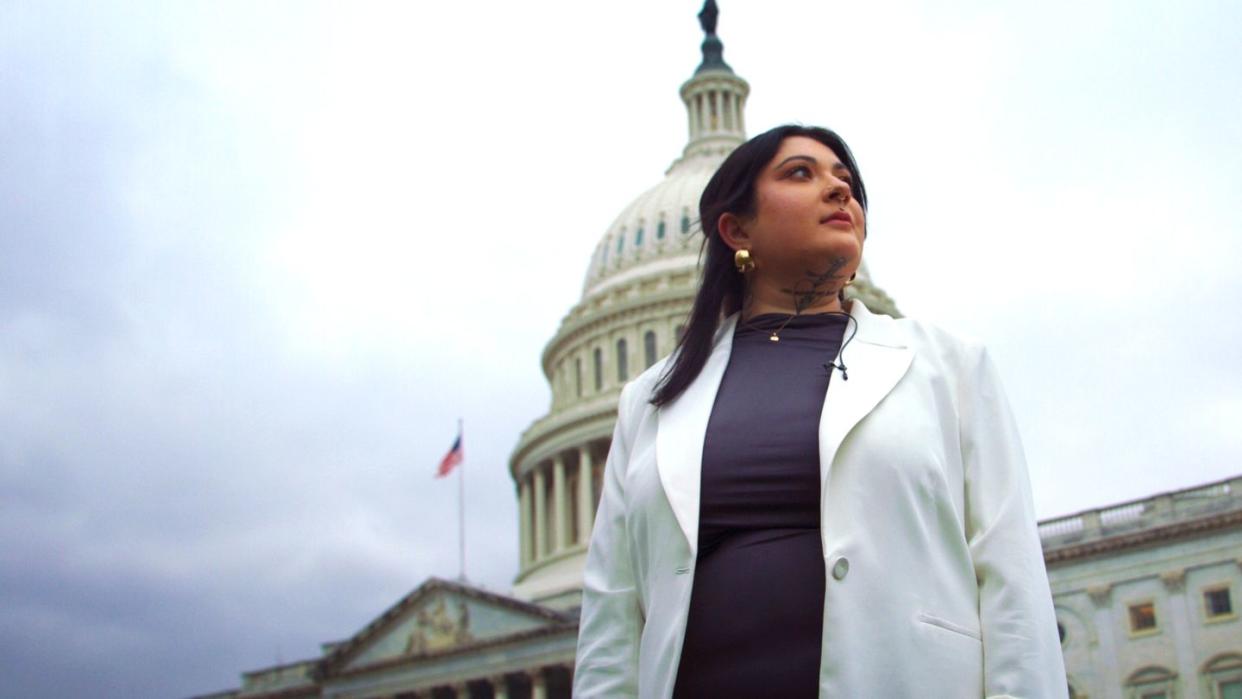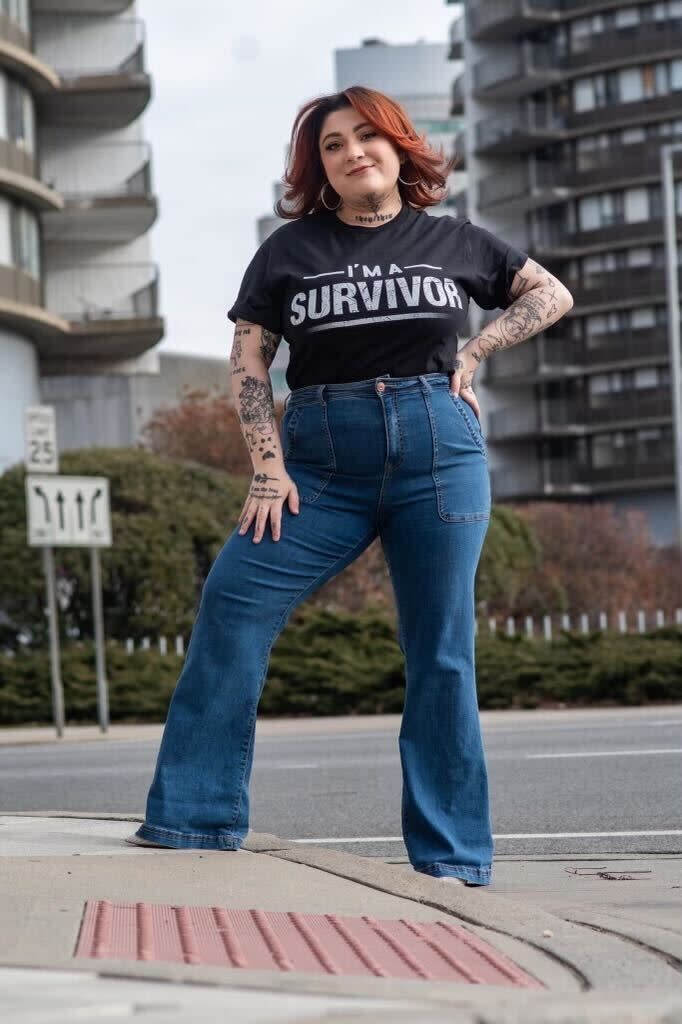‘Nude Images Of Me Were Spread Online As A Young Teen. Now I’m Fighting To Protect Other Survivors.’

Leah Juliett is an Image Based Sexual Abuse (IBSA) expert and survivor, activist, and founder of the March Against Revenge Porn.
When I was a young teen, a boy I knew pressured me to send nudes over Facebook Messenger. Over a decade later, I still have all of the messages. He would compliment my body and show interest in me before asking for intimate photos. And when I denied him, he would rescind his interest. I deeply wanted to be loved and to be seen. For years, I had a very negative relationship with my body and self-image. Being “seen” by this boy was of value to me.
Eventually, after a year of being pressured, I sent him the four photos he requested. My breasts, my face—all of me was exposed. I made him promise he would never share them. He laughed at me, like it was silly that I would think he would violate my privacy and my consent. But that’s exactly what he did.
I will never know the exact thing that triggered him (I’ve never been able to speak to him about it, nor does any excuse justify his abuse), but around the same time I started to come out as queer, he told me that he was going to ruin my life. I didn’t know what that meant at the time, and I wasn’t able to understand the gravity of the situation in the way that I do now. He ended up sharing my nude images on Facebook Messenger to a group of boys from our town. They spread through my high school like wildfire. They were disseminated throughout my city. And I thought: This is as bad as it’s going to get—kids in high school looking at me like they’d seen me naked. But it got worse.
The photos were posted on an international image board called Anon-IB, where my name, age, town, face, and body were disseminated and accessible for well over five years. They’re likely still there today.
I stayed silent for a really long time after this happened. My abuser knew where I lived. He knew my little sister. He knew where I went to school. I knew that if I tried to speak out against him, I would be blamed and slut-shamed by my community. I felt like he owned me, my dignity and my safety. I was also very, very scared that I would be arrested. (In Connecticut, we didn’t have legislation that protected survivors of image-based sexual violence from also being held accountable for sharing the photos.)
I did my best to make myself as invisible as possible. I was afraid that if I didn’t make myself absolutely small and silent, something worse would happen, that more people would find out, that the photos would get posted in other places. When I went to college, I moved out of my small hometown and began depending on self-harm and alcohol to heal my pain. During this time, at 19 years old, I had what Dr. Spring Cooper, a survivor and researcher in this field, calls a “f*ck it” moment. A moment where I was shaken awake.
I had opened up Facebook on my laptop and saw a news article showing a mug shot of the man who had abused me as a teenager. It was a visceral moment, seeing his mug shot staring back at me. It’s burned into my brain. And I said, “Okay, this man is either going to kill me because I am driving myself to death the way that I’m handling the trauma of this situation, or I’m going to act.” In that moment, I decided to save my life, and I decided to act.

I wrote a poem; I started to do research. There weren’t many resources out there at the time for “revenge porn,” as I knew the term, or other people talking about it. (I now know that I never did anything to warrant “revenge,” and that my body is not inherently “pornographic,” especially my childhood body, so the correct terms are “image-based sexual violence” and “child sexual abuse material.”) So, I decided to talk about my experience, and it started getting a fair amount of attention. I held a protest march across the Brooklyn Bridge, the March Against Revenge Porn, on April 1, 2017. It was a big cultural moment and a big personal moment for me. It skyrocketed me into the advocacy space, where I’ve been ever since.
For the past decade, I’ve been healing the parts of me that are cracked and broken inside as a result of this abuse and exploitation. And now, at 27, I am in a place where—despite my cracks and despite my brokenness and despite the trauma that lives in me—I am strong enough to advocate against the people, the structures, the institutions that allowed abuse like mine to happen. Now, I’m focused on accountability for abusers.
I work with two coalitions that fight online image-based sexual violence and child sexual abuse material on the Internet, and we’re working to hold tech companies and abusers accountable.
During the Senate Judiciary hearing in January, I was in the room listening to top tech CEOs testify in front of Congress. I was joined by fellow survivors, and I watched parents and families of children who’ve died because of sextortion via this technology speak. There were stories of young people who bought fentanyl-laced pills on Snapchat, of young men who took their own lives after being sextorted. And it made me realize that this abuse and violence made possible through our tech and social media is impacting so many of us in so many unique ways.
I was abused in an Internet and social media landscape that looked a lot different than it does now. There were no precautions or tools to help protect and prevent this type of abuse on platforms. Now, I feel lucky to live in a moment where my voice has value and the five years I suffered in silence are not in vain.
But passing federal legislation is deeply important. We don’t have laws criminalizing nonconsensual image sharing in all 50 states. (It’s a misdemeanor in some, and a felony in a few others.) If I had the power to change things right now, I’d immediately pass the suite of bills proposed to protect children and prevent their online abuse:
The EARN IT Act, which allows websites to remove user-posted content deemed inappropriate and removes blanket immunity for violations of laws related to online child sexual abuse material (CSAM)
The SHIELD Act, which makes it a criminal offense to distribute intimate visual depictions
Kids Online Safety Act (KOSA), which would protect children online by enabling stronger privacy settings; making it easier to report harmful behavior; mitigating the proliferation of content that promotes eating disorders, substance abuse, CSA, and suicidal ideation; and requiring independent audits of how social media platforms are doing
When I started talking about this 10 years ago, nobody wanted to hear me. Nobody wanted to publish my story. Attorneys didn’t want to work with me because I was under 18 when the incident occurred. Everybody blamed me and nobody cared. But now, we’re at an inflection point. I’ve been begging everyone to listen to me on this issue for a decade, and people finally seem to be waking up. During the State of the Union, President Biden said it was time to pass legislation to protect children online. My dad texted me: “I heard that and I immediately thought of you.”
If I could tell every young person one thing, it would be to instill in their brains that regardless of what happens to you, that abuse is never your fault. And if it takes you two days or two years, five months or five years to say what happened to you, there will always be someone to listen. There is a community of survivors, experts, and allies in this space who are ready to support and affirm you. You don’t have to just survive. You deserve to live out loud.
You Might Also Like

 Yahoo News
Yahoo News 
